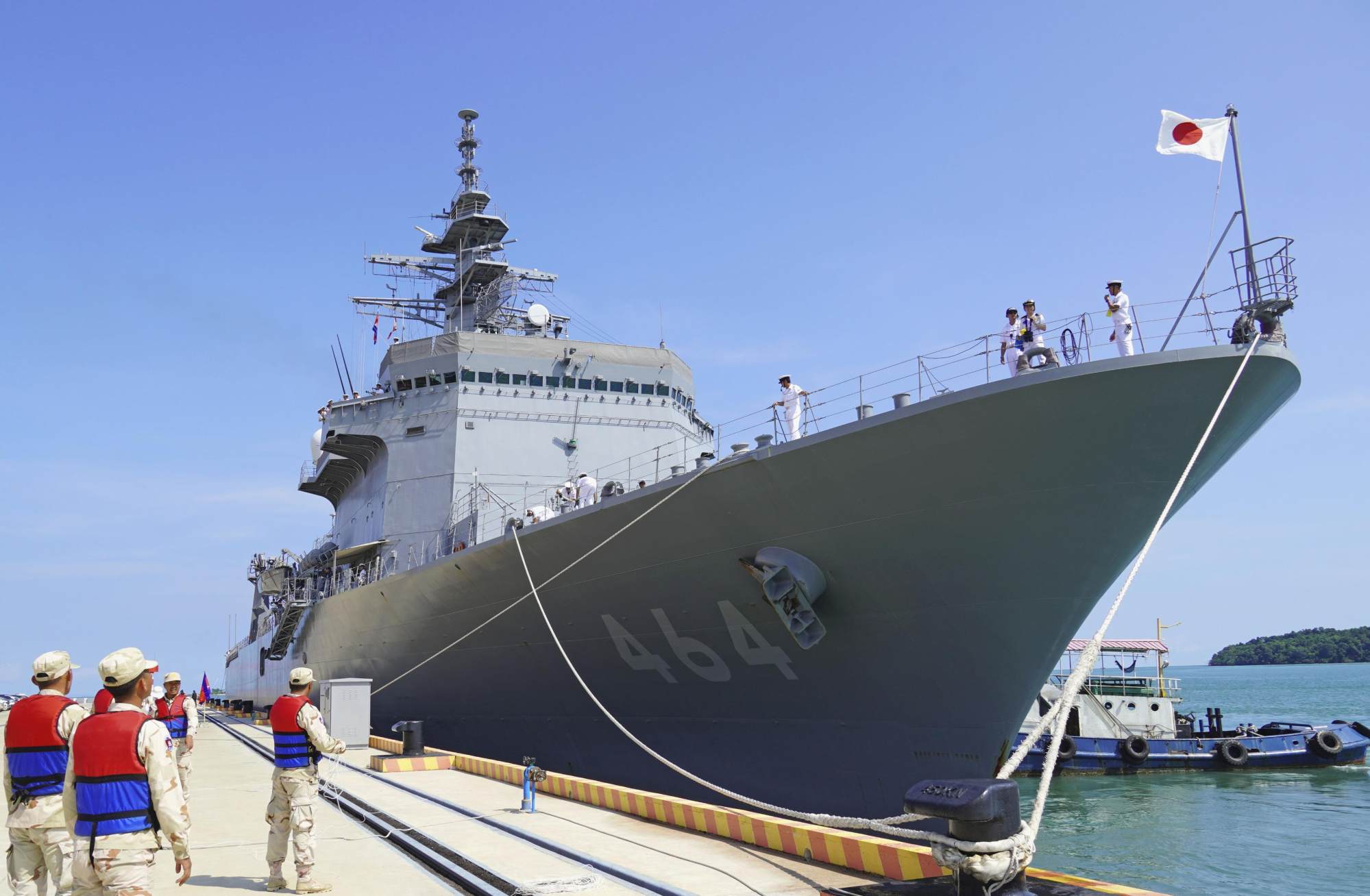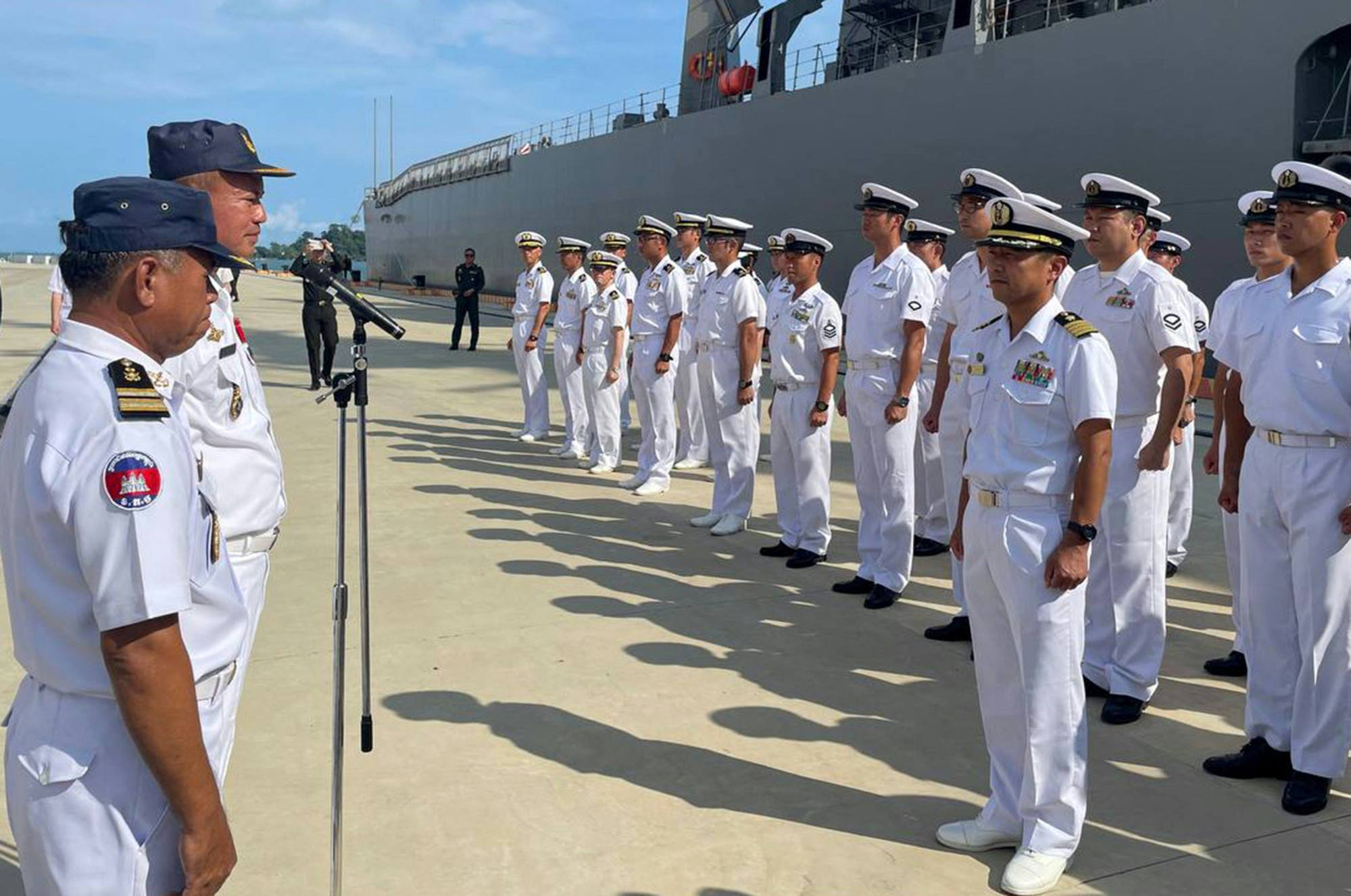A port visit indicates that Cambodia stays ‘receptive to collaboration’ with other countries, and experts assert that the Ream Naval Base is not solely intended for Chinese utilization.
The two Japanese minesweepers have made the initial docking of foreign military ships at Cambodia’s expanded Ream Naval Base, which was funded by China. This step is probably intended to demonstrate that the base will not be used exclusively by Beijing, despite ongoing doubts about increased Chinese military presence in the area.
The visit by the Bungo and Etajima, both part of the Japan Maritime Self-Defence Force, began on Saturday and lasted for four days, bringing 170 sailors to the recently upgraded facility on the Gulf of Thailand.
Experts indicated that the visit to the port served as a symbolic yet strategically significant gesture from Phnom Penh, asserting its continued authority over the naval facility, which has been a focal point for U.S. worries regarding China’s expanding military presence in Southeast Asia.
Shin Kawashima, an international relations professor from the University of Tokyo, states that Cambodia aims to highlight that Ream will not be solely dedicated to the Chinese Navy, and asserts that the country retains control over the base.
He emphasized that the crucial test would involve observing how frequently warships from various nations utilize the base and determining if they are significantly outweighed by Chinese ships. “Should Chinese vessels consistently dominate to a considerable extent over those of other countries, assertions about the facility being ‘open’ might provoke doubt among neighboring states,” Kawashima pointed out.
In 2019, concerns about China’s involvement at the Ream Naval Base came to light due to reports suggesting an impending deal which could provide Beijing with a 30-year lease enabling the deployment of troops, weapon stockpiling, and naval vessel entry. However, Cambodia refuted these allegations, whereas the U.S. expressed repeated concern regarding this matter.
Following significant development at Ream—widely thought to be financed by China—the Japanese port visit takes place. Phnom Penh insists that the facility stays accessible to various “friendly nations” and cites the Japanese arrival as evidence of their dedication to an inclusive approach.
For Japan’s part, Kawashima said Tokyo wanted to demonstrate that it shared the concept of a Free and Open Indo-Pacific (FOIP) with Cambodia.
Introduced by former Japanese prime minister Shinzo Abe and formalised as a strategy in 2016, the FOIP is aimed at promoting the rule of law, freedom of navigation and free trade.

Kawashima emphasized that port visits served as an exceptionally efficient method for understanding the Ream Naval Base. Additionally, he pointed out that selecting minesweepers over patrol boats was intended to prevent giving the impression that Japan was militarily opposing China.
“The [move] was likely intended to convey the meaning of activities for international contribution or training for such purposes,” he added.
Chhay Lim, a research fellow at Cambodia’s Institute for International Studies and Public Policy’s Centre for Southeast Asian Studies, described the arrival of the Japanese vessels as a meaningful moment in Cambodia-Japan ties.
“[It] sends a strategic message [that] Cambodia is open for cooperation beyond just China,” Lim said.
While one visit would not erase deeper concerns about possible Chinese military access, Lim said it still helped Phnom Penh “show that it still holds the pen in shaping its defence relationships”.
The shift in foreign policy under Prime Minister Hun Manet, who took office in 2023, signaled a “more intentional approach to maintaining diversified alliances,” according to Lim. It was noted that this indicates Cambodia maintains control over its interactions with various countries.
Citing the Khmer saying “we do what’s best for ourselves, let others think what they want”, Lim noted that the Japanese vessels’ visit was about reminding the world that Cambodia still had “room to manoeuvre, and intends to keep it that way”.
In light of the unpredictable US policy under the Donald Trump administration, Lim said Japan understood that countries in the region were increasingly worried about a riskier world.
“It’s an opportune moment for Tokyo to present itself as a stable, reliable, and unthreatening ally in the area,” Lim stated. “Japan has consistently focused on the long-term strategy in Southeast Asia, and this visit indicates its readiness to discreetly engage with intricate situations without causing a stir.”
The Japanese ships showed up one day following Chinese President Xi Jinping’s two-day state visit to Cambodia last week.
In addition to emphasizing China’s “unbreakable” alliance with Cambodia, Xi urged the nation to “stand against protectionism” and “reject hegemonic practices.” During his visit, both nations inked 37 agreements covering areas such as investment, trade, and finance.
China, which is both a close ally and the biggest lender to Cambodia, has over recent years poured billions of dollars into various projects in the country, such as road constructions and airport developments.

In recent years, Tokyo has also bolstered relations with Cambodia, which many view as an effort to counterbalance China’s growing influence in the area.
A statement released by Japan’s embassy in Cambodia on Saturday mentioned that the two ships embarked on an expedition starting in January, aimed at visiting 11 nations spanning across Africa, the Middle East, as well as South and Southeast Asia.
Kawashima mentioned that Japan shared concerns over the halt of initiatives by the US Agency for International Development during the Trump administration, which caused significant worry amongst numerous developing nations in the area.
Tokyo needs to work alongside other U.S. allies and nations with similar values to tackle how they should react to these shifts and ease worries over Washington’s retreat, he noted.
“The recent visit of the Japanese Maritime Self-Defense Force to Ream’s port probably holds significant importance,” Kawashima noted.
More Articles from SCMP
For the first time since 2017, six higher education institutions based in Hong Kong have ranked within the top 50 in Asia.
Trump ‘is panicking’ about tariffs, China unveils its largest warships: SCMP daily highlights
Alexis Badel prepares for his Champions Mile challenge by achieving a remarkable hat-trick at Happy Valley.
The European Parliament is in the ‘final stages’ of negotiations with China aimed at lifting sanctions imposed on legislators.
The article initially appeared on the South ChinaMorning Post (www.scmp.com), which is the premier source for news coverage of China and Asia.
Copyright © 2025. South China Morning Post Publishers Ltd. All rights reserved.


